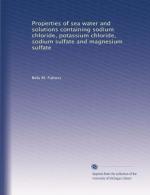|
This section contains 914 words (approx. 4 pages at 300 words per page) |

|
Overview
Magnesium sulfate (mag-NEE-zee-um SUL-fate) occurs as the anhydrous salt and in a number of hydrated forms, including MgSO4·H2O, MgSO4·4H2O, MgSO4·5H2O, MgSO4·6H2O, and MgSO4·7H2O. The heptahydrate (MgSO4·7H2O) is commonly known as Epsom salts. All of the hydrates occur in nature as the minerals, respectively, kieserite, starkeyite, pentahydrite, hexahydrite, and epsomite. Magnesium sulfate in all forms is a colorless or white crystalline or powdery material with no odor but a bitter taste. The hydrates all lose their water of hydration when heated. For example, the heptahydrate loses one molecule of water spontaneously at room temperature, four molecules of water when heated above 70°C (160°F), six molecules of water at 150°C (300°F), and all seven molecules of water above 200°C (400°F).
Key Facts
Other Names:
None
Formula:
MgSO4
Elements:
Magnesium, sulfur, oxygen
Compound Type:
Inorganic salt...
|
This section contains 914 words (approx. 4 pages at 300 words per page) |

|


